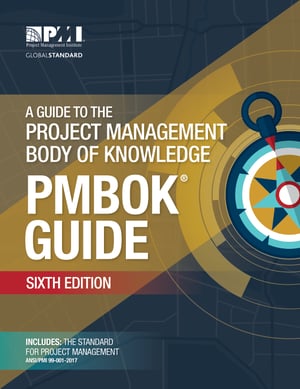
Project management is necessary for organizations of all types and sizes, whether it is formally recognized or not. But for complex organizations, applying a standard for project management and professionalizing the role of project manager helps improve results.
A Guide to the Project Management Body of Knowledge (PMBOK® Guide) is the Project Management Institute’s flagship publication. The guide lays out well-proven, consensus-based practices that are widely used.
The PMBOK® Guide is developed by active project management practitioners and subject matter experts. The project management community reviews it before it is released to make sure it continuously reflects the profession’s current state.
The Project Management Institute
The Project Management Institute (PMI) is a global nonprofit professional organization for project management. The PMI serves more than 2.9 million professionals, including over 500,000 members in 208 countries and territories around the world.
PMI offers eight certifications that “recognize knowledge and competency,” including the Project Management Professional (PMP)® certification, which serves as the standard of professionalism in the field. To earn a PMI credential, candidates must document that they have met required education and experience requirements, then they must pass an exam.
What is the purpose of PMBOK®?
PMBOK® is the standard by which PMP (Project Management Professional) certification through PMI is obtained. PMP is an important industry-recognized certification for project managers. The PMBOK® goal is to enable organizations to standardize project management practices across departments. It also helps project managers work with a standardized system across organizations. This means that a project manager who moves from one company to another can use the same practices.
The methods are well documented and focus on practices that have been proven to work. The guide also discusses what doesn’t work, so managers can avoid common mistakes.
The PMBOK® Terminology and Guidelines
The PMBOK® structure includes five process groups, ten knowledge areas, and 47 project management processes. The knowledge areas group the PM processes by project management content.
5 Process Groups
The 47 project management processes are grouped into five distinct sets:
Initiating
The first process group, initiating, involves setting the vision of what will be accomplished and defining project success. During this phase, the project is authorized by the sponsor, the project manager is assigned, the scope is defined, and stakeholders are named. Not all projects will make it past the initiating process group.
Planning
The planning process group involves activities that further hone the scope of the project, including identifying risks, milestones, and budget. A planning process called progressive elaboration occurs, and project documents are developed.
Executing
This phase is all about orchestrating activities according to the timeline and communicating with the sponsor and stakeholders. Most of the budget is spent during this phase, which results in the expected deliverables.
Monitoring and Controlling
Monitoring and controlling include processes needed to track, review, and regulate the project’s progress and performance.
Closing
Project management is distinct from other forms of management because projects are time or milestone limited. Closing tasks include getting acceptance from the customer, archiving records, closing contracts, reviewing lessons learned, and celebrating success.
10 Knowledge Areas
The ten knowledge areas define the fundamentals that every effective project manager needs to grasp.
Integration
Integration is the ability to bring together all inputs to manage the project as a whole and not in chunks or fits and starts.
Scope
The scope makes clear what the project will deliver and what is excluded. Project managers need the skills to gather requirements and define the scope and stick to it.
Time
The knowledge area of time involves understanding the time commitment of each person to their project tasks and projecting the overall timeframe of the project.
Cost
Where necessary, there must be a budget associated with each task. Project managers should have the cost management skills to accurately forecast the overall budget.
Quality
Quality control and management must be backed-in to every project activity so that the results will be in line with expectations.
Procurement
Project managers should be adept at procuring both supplies and resources in a way that adds value and minimizes waste.
Human resources
Excellent project managers build teams that have, or can grow, the skills necessary to get to the finish line. They keep team members engaged and recognize achievements.
Communications
It is sometimes said that a project manager’s job is 80% communications. The PM is responsible for keeping the sponsor and all stakeholders informed about the project status or any roadblocks.
Risk management
Project managers should have the skills to assess risk and complete qualitative and quantitative risk assessments across the project’s life.
Stakeholder management
Successful project managers understand who is impacted by the project and keep the needs and concerns of those people front and center throughout the lifecycle of the project.
How does PMBOK work?
Although the approach provides structure to project management, each project will have its own nuances. Let’s consider one real-life example.
A software company realized the need to replace out-of-date contact center software. Here’s how the project progressed through the PMBOK framework.
Initiating
A project manager was assigned, and the initiative received executive approval.
Planning
The stakeholders from several business functions were identified, and the team met to define the objects of the project and set a general timeline. The budget for new software was set. Baseline measurements for call abandon rates, wait times, and call diversion were established.
Executing
Vendors were evaluated, and a selection was made. The team was trained, and the selected solution was implemented. Relevant information was shared with stakeholders.
Monitoring and Controlling
Daily measurements for the key performance indicators identified in the planning phase were monitored. Adjustments to processes were made.
Closing
After the stated goals were reached and all associated tasks were complete, the project was successfully completed.
For organizations and project management professionals that want to bring a higher level of sophistication and standardization to the table, A Guide to the Project Management Body of Knowledge is an excellent place to start.


Add a Comment